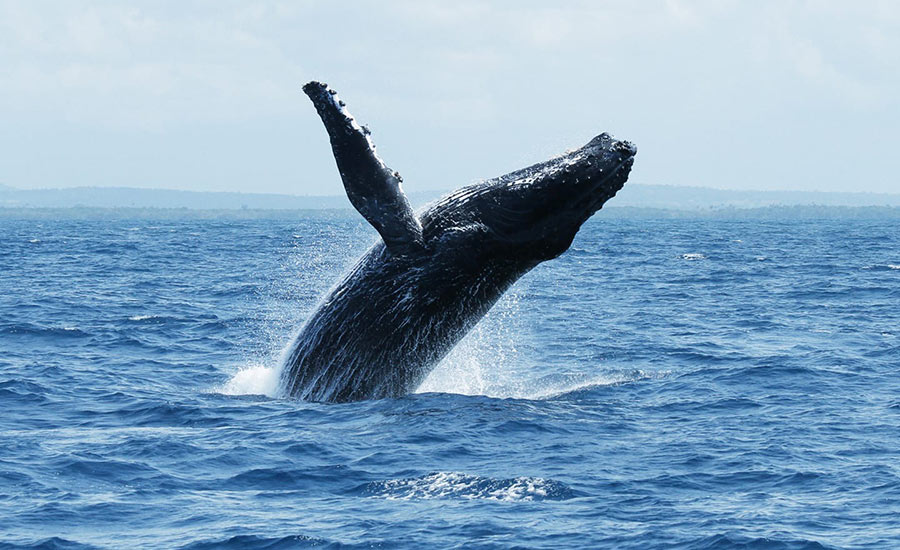
Whale watching in Watamu, part of Kenya’s Twin Migration!
The Great Migration of a million plus wildebeest across the plains of Kenya – and Tanzania – combined with the annual migration of whales along Kenya’s coast make a compelling case for visiting East Africa at this time of year.
Did you know…? Between July and September, humpback whales pass close to the shores of the Kenyan coast. Why? They gather in the warm Kenyan waters to calve and mate. If you’re into wildlife – like I am – whale watching is another not-to-be-missed ecotourism experience!

Below are extracts from an article in Kenya’s The Nation entitled Travelling to Watch Whales in Kenyan Coast.
Armed with a pair of binoculars and a good viewing spot, Charlotte Beauvoisin, a British travel blogger who lives in Uganda sat at the shore watching the whales from land.
“I got a sneak peek from behind the scenes with the Watamu Marine Association land research team,” she says.
Charlotte Beauvoisin, The Nation – Business daily, 9 August 2019
I’m a huge fan of the conservation work and ecotourism activities developed by the Watamu Marine Association. On a previous visit I was lucky enough to accompany WMA’s dolphin monitoring team onto the ocean. For over an hour, we watched a pod of 20 dolphins on this same stretch of coast. As soon as the WMA team mentioned that they now organise whale watching tours, I just had to see them!

“If a whale watching boat does not see the animals, a guide or researcher will communicate with the land base which increases the chance of visitors to see whales. When I was with the land team, it was early in the season so we couldn’t see the mother whale and calves that come as close as 500 metres from the shore. However, as I was watching there was a call from one of the boats, Alley Cat, to tell me that I was looking at a whale just slightly outside out of range. In the next few hours, seven whales were seen from the boats in the ocean,” Charlotte says.
She has always been fascinated by whales; their size, grace and eerie, unusual songs. “I’m terrified of deep water so I have immense respect for how whales live and the many thousands of miles they swim every year as they migrate.”
Last week I travelled to Watamu to meet Jane Spilsbury and Steve Trott of the Watamu Marine Association. They work closely with Hemingways Watamu, Kenya’s first hotel to offer whale watching excursions.
The whale migration through Kenyan waters normally starts at the beginning of July and ends in September (although sightings have been made as late as November in some years). “It is expected that the whales will start to increase in numbers as the migration peaks in August,” says Jane. In October, the whales make their 5,000 km return journey to Antartica, their main feeding area. During the peak month of August, humpbacks – said to be “among the most acrobatic of whales” – can even be seen from shoreside bars and hotels such as Hemingways and Ocean Sports Bar. The whale watching tours follow WMA’s responsible whale watching guidelines.
How much does it cost to go whale watching in Watamu?
Whale watching costs between $450 and $100 for a morning or afternoon boat trip that lasts about 4 hours. There’s a good chance of seeing other marine mammals such as sea turtles and dolphins on a whale watching trip.
Would you believe it – these are the teeth of a Sperm Whale!

In 2018, the 17 metre long body of a Sperm Whale (Physeter macrocephalus) was washed up at Kwale, on the Kenyan coast. My friends at Watamu Marine Association were quick to visit the scene. Watch the story of the beached Sperm Whale unfold. It’s quite something. (One quick thinking local was there to take and print selfies for the crowd who gathered at the scene!)
The Sperm Whale is 1 of 24 marine mammal species identified by the Watamu Marine Association along this stretch of coastline.
Once upon a time, Sperm Whale teeth were much in demand by seamen who used the teeth to carve intricate images. This artwork was known as scrimshaw. The image was scratched onto the surface of a Sperm Whale tooth using a knife or needle. Scrimshaw art was popular with 19th century whalers.

If you love the sea, there are so many thrilling ways to experience nature in Watamu: snorkeling, whale watching, dolphin monitoring, turtle conservation. (Whatever next – sharks?)
For more information, visit Watamu Marine Association’s web site. To book a whale watching trip between July and September, contact +254 (0) 724170154 / (0)731697356 or fishing.centre@hemingways.co / michael.mwangombe@watamumarine.co.ke
Here is my favourite blog from the coast, all about Kenya’s dazzling marine life: where to snorkel in Watamu.



























Hello from Watamu Marine Association who are welcoming the whales in Watamu Kenya,
We have been studying the humpback whale migration for the last 7 years and enjoyed sharing the experience with guests. An interesting situation has arisen this year when the whales appear to be delayed in their migration. We believe it maybe caused by the warming temperatures in the Antarctic which has affected the whales’ favorite food, krill which is no longer widely available. For expectant or would be mums, it is important that they all bulked up for the 5000 km journey to Kenya, especially when they are also feeding baby, so they may have stayed in their feeding grounds a little later than normal
Currently the whales are still in South Africa and maybe on their way in numbers in the next few weeks. We will keep you informed from the ocean!
Certainly whales are smart mammals and know what’s best for them
Fascinating to hear live updates from the ocean! Will be following events closely on your Facebook page!
With love from the forest x
Amazing pictures, what amazing creatures. At first, I thought you were holding bananas 😀 Thank you for this post.
LOL yes those teeth do look a bit like bananas! (Not very easy to peel tho!)
If you’re interested in the ocean, check out this gorgeous graphic from Wildlife Conservation Society all about sharks and coral reefs. It explains how “Healthy sharks equal healthy oceans.”

Fantastic to see that CNN Travel has written about whale-watching and the Twin Migration. Kudos to Jane Spilsbury, Steve Trott, Mike Mwang’ombe, Watamu Marine Association and the local fishing and tourism communities!
“Up until recently, most travelers, and even some locals, had no inkling of the aquatic mammals that occupy or pass through Kenya’s waters.
Known as a safari destination, with the wildebeest migration in the Maasai Mara between July and September considered its pinnacle, the African nation’s expansive marine life was something only fishermen knew the true extent of.
But largely thanks to the efforts of a former lawyer from London, the country now has a burgeoning marine tourism industry, with tourists seeking out the coastal town of Watamu, located 140 kilometers north of Mombasa, for its humpback whales.
The tide began to turn around 10 years ago, when Jane Spilsbury, who had been living in Watamu with her marine biologist husband for several years, began hearing tales from local fishermen of dolphin and whales sightings.
Determined to prove their existence, the pair spent six months boarding local fishing boats armed with just a few scraps of paper and a cheap camera in order to document and photograph any visible evidence.”
Read “The woman who helped reveal whale migration in Kenya” by Ashleigh Stewart, CNN Travel.
Updated 6th January 2021
https://edition.cnn.com/travel/article/whales-in-kenya-scn/index.html